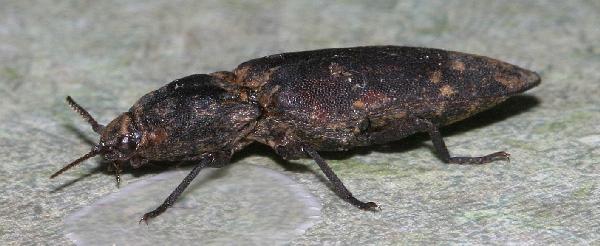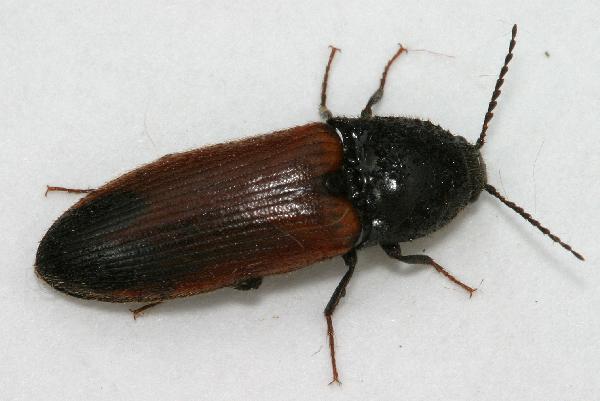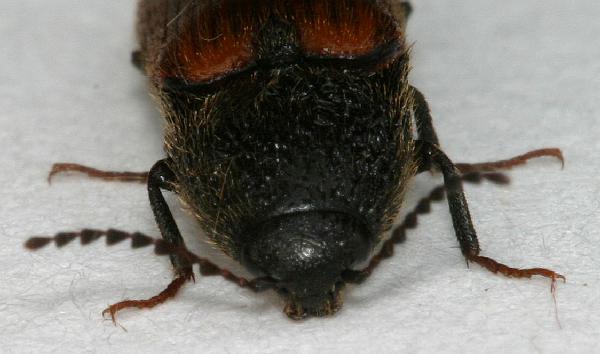Three Click Beetles
Last winter, on March 16, 2011, a friend found this click beetle in his supply of wood for his wood-burning stove (Hi, Bill!). Since he thought it was odd to find an active beetle in what is, for us, still the middle of winter, he brought it to me to see if I had any ideas as to what it was:
Aside from recognizing it as a click beetle, I didn’t have a clue. Click beetles (family Elateridae) are common, have a lot of different species that nevertheless all look broadly similar, are not very charismatic aside from their amusement value to small children, and largely lack economic impact on humans. As a result, it is often pretty difficult for me to tell them apart, other than recognizing the distinct feature that makes them Click Beetles. So, I posted it on BugGuide, where it was quickly identified by click beetle expert Blaine Mathison[1] as probably being Danosoma brevicorne.
That readily-identifiable feature of click beetles that I mentioned is their specific shape: they are elongated, oval beetles that are very stiff and rigid, except for a highly-flexible joint between their head/first thorax segment and the rest of their body.
When a click beetle is either caught on its back, or captured by something that it thinks is a predator, it will flex its head back and cock a mechanism in its “neck”. This locks the neck in the flexed position while it tenses muscles and stores up energy in the joint. All the click beetles I’ve examined closely have a kind of a prong on their underside that fits into a socket in the next segment. The prong is a key part of their click mechanism.
Here is a video of how the click mechanism is supposed to work. There is supposed to be a second spine that projects up and catches on the bottom of the prong, locking the neck in the flexed position. Once the clicker is tensed up, the beetle somehow releases the catch. This lets its head end snap forward with an audible “click!” and the beetle is hurled into the air (or, if it is being held by some other animal, the vibration from the click is likely to either jar it out of its captor’s grasp, or startle the captor enough to make it drop the beetle). Here’s a short video of a click beetle clicking, just in case you’ve never seen this before.[2]
This particular beetle was probably pretty old (it certainly looked old), and apparently had a nearly worn-out clicker. In particular, I think the lower spine that was supposed to engage with the neck prong has either worn away or broken off. Which is why I was able to get pictures of it flexing like that. Normally, they click and jump around so much that getting a picture of the clicking action needs a high-speed camera.
So, while we are talking about click beetles, here’s another one that got into our house on June 4, 2011. Sam found it on the floor near the back door. It wasn’t very active, and I’m mainly including it to show how click beetles are broadly similar yet different in specifics. It still has the characteristic click beetle shape, but instead of having little scales, it is covered with very fine hairs. It was also very slippery.
It didn’t click, it just laid there in a tucked position. It had probably just come out of hibernation a short time before, and wasn’t really up to strenuous activity yet. Blaine Mathison also identified this one for me: it is in the genus Melanotus, a group of practically indistinguishable small click beetles that can only be identified to species if you have the specimen in hand and a magnifying glass so you can go through an ID key.
And, here’s yet a third one that we found on July 20, 2011 while we were shaking our mulberry tree to harvest the fruit. There were probably six of these click beetles in about two gallons of mulberries, which is quite a lot for beetles this size.
Blaine also identified this one to genus; he says it looks like an Ampedus. Of course, that still leaves an estimated 70 possibilities for the species, but it’s a lot better than I probably would have done unassisted.
Click beetles are almost all herbivores or detrivores, and evidently at least one species likes juicy fruits. At least, I can’t think of any other reasons why they would have been in the mulberry tree in such numbers.
As you can see, the jaws are not very pronounced. They are the sort of thing that is used for scraping up fungus adhering to soil and rocks, or lapping up fruit juices.
Overall, Click Beetles are very successful. Bug Guide says that there are an esimated 1000+ species just in North America, and click beetles are found everywhere except in aquatic environments (where the click mechanism probably wouldn’t work) and in severe arctic and alpine environments (where it is so cold that pretty much no insects live there). The click strategy does appear to be a very effective trick to keep from getting eaten.
——–
[1] Blaine Mathison says on his BugGuide profile page that he’s interested in receiving specimens of click beetles from all over North America. So if you catch a click beetle, shoot Blaine an email and ask if he would like to receive it. I plan on sending him some next summer when they start coming out again.
[2] It looks like that video was made by The Dragonfly Woman, who writes one of the insect blogs that I read regularly.
Comments are closed.











Carrion beetle larvae, family Silphidae, were found at a hypothetical murder scene in an indigenous forest in South Africa in 09-Aug, after having gone missing on 08-Jul. Knowing that blowflies are the first to invade a carcass, how would we go about determining the time of death using Growth Rates?
Help is much appreciated.
Chanel: I don’t know. I suppose the best way to start is to pick up a Forensic Entomology text and read up on South African Silphidae. Or at least check the writeup on Wikipedia about determination of growth rates of Silphidae larvae in a carcass, and follow up on it from there.
I’d like to leave a comment just so you know I’m still reading, but after Chanel’s, anything I might have to say would be the very definition of anticlimactic.
Yes, it is hard to follow up after that. I think bringing up forensic entomology at most parties would probably be a sure-fire conversation-stopper, too.
The interesting thing is, the way that Chanel’s question is phrased, it looks like it might be a homework question for a class. Hopefully a forensic entomology class. Although, it would be a good question for a mystery writers’ workshop, too.
I think it likely the click mechanism would work fine underwater. There are a large number of aquatic insects that use noise for both intraspecies and interspecies ‘communication’ while underwater. Caddis in the family Hydropsychidae typically use stridulation to maintain territory with their conspecifics, etc.
There are lots of other examples too.